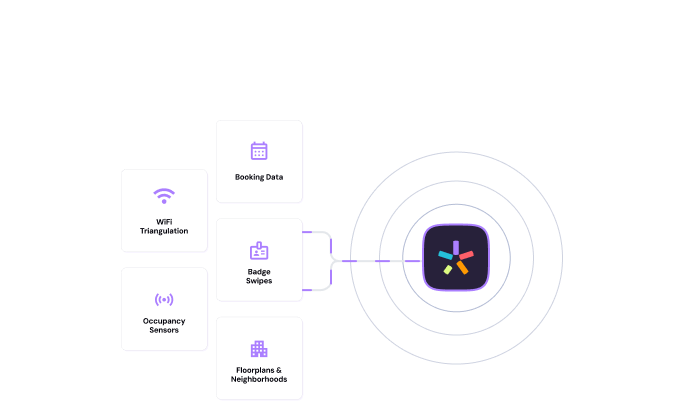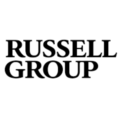Space utilization software
Make decisions from a single source of truth
Eliminate data headaches and make faster decisions, with patented technology that aggregates utilization data from any source, including WiFi, sensors and badge.



Optimize hybrid occupancy
Dynamic occupancy management
Hybrid attendance patterns make predicting occupancy more challenging than ever. Real-time space utilization insight allows workplace leaders to dive into what’s happening in any building, floor or zone right now – enabling rapid action to ensure a smooth workplace experience.
- Check out your busiest zones and make real-time decisions on whether to open up more space in a nearby team neighborhood that’s underutilized.
- Help employees decide where to go by surfacing real-time utilization data in lobby displays or mobile apps
- Holding a town hall meeting and expect a busy day? Dive in and check whether your event space is reaching capacity

Workplace intelligence
Space utilization data in a single pane of glass
Workplace leaders are rethinking occupancy metrics to focus on workplace experience. Badge swipes are no longer enough. Hybrid occupancy management requires comprehensive data to inform your dynamic workplace strategy.
- Aggregate data from multiple sources into a single pane of glass
- Assess current reality with descriptive, predictive, prescriptive analytics
- Act quickly and decisively based on actual behavior and usage
Data-driven space management
Say goodbye to guesswork
Hybrid occupancy management can have an extraordinary impact on employee workplace experience. It all starts with reliable, holistic data that powers effective decision-making.
Overcome occupancy blindspots
Get a complete, granular picture of utilization at any level of detail: from portfolio and building level to team neighborhoods and spaces

Remove data headaches
HubStar's patented technology automates data unification and eliminates complexities like double-counting

Occupancy threshold alerts
Cut through the noise with easy to configure threshold alerts that prompt action if a space is nearing capacity

No new hardware required
Get a cost-effective, portfolio-wide view of utilization using your existing WiFi infrastructure. Add optional sensors as required

Space utilization metrics
Get out-the-box space utilization metrics with PresenceIQ
PresenceIQ delivers the intelligence you need to track workplace performance and continuously improve employee experience. Get out-the-box metrics, predictions and smart suggestions.
- Analyze and predict hybrid attendance
- Adopt a data-driven approach to hybrid space design and retrofits
- Inform portfolio right-sizing and lease decisions

Advanced workplace analytics
Measure real estate effectiveness
Get more value out of every square foot, with cost effective options for measuring utilization across your entire portfolio using your existing infrastructure.
Boost workplace effectiveness with H2O
Explore H2O platform solutions

Increase office demand
Boost collaboration and employee experience with Connect
Advertise office events and help employees choose the ideal day to come in with next-gen scheduling
Learn more
Measure & predict utilization
Act on data not assumptions with PresenceIQ
Workplace intelligence that empowers data-driven portfolio optimization and space design decisions
Learn more
Optimize hybrid occupancy
Manage people, places and policy in a central Hub
Centralize your people, place and policy data; and manage neighborhoods, sharing ratios and floor plans
Learn more
“We will not make any meaningful real estate and workplace decisions without HubStar data.”

Head of Real Estate
Fortune 500 Organization
Frequently asked questions
Space utilization FAQs
Still have questions? Browse our FAQs below, and contact us if yours isn’t covered.
How do you measure space utilization in the workplace?
Space utilization is measured by tracking how often and how long specific areas in a workplace are occupied. This can include desk usage, meeting room occupancy, and common space traffic. Optimizing space can reduce real estate costs, improve workplace productivity, and ensure that your office is set up to meet the needs of employees.
What types of data sources can be used to track space utilization?
Space utilization can be tracked using data from a variety of sources, including WiFi connections, occupancy sensors, badge swipes and scheduling systems. Aggregated and normalized, these data points provide a comprehensive view of how spaces are being used, and how to optimize them.
How does space utilization data help improve workplace efficiency?
By identifying underused or overcrowded areas, organizations can use these insights optimize their office space, especially in hybrid work environments with fluctuating occupancy. By aligning space usage with employee needs, companies can reduce wasted space, lowering costs and carbon, while improving resource allocation, employee experience and workplace effectiveness.
How can space utilization data help inform space management and space planning?
Space utilization data reveals how different areas are used, highlighting which spaces are over- or underutilized. For example, it may show that workstations are often vacant while collaborative spaces are frequently in demand. With this data, organizations can make informed decisions, such as converting unused desks into meeting rooms or collaboration zones, aligning office layouts with employee needs. This proactive approach maximizes real estate efficiency and optimizes the workplace for productivity.
How does space utilization technology support hybrid working models?
Workplace leaders can optimize space for fluctuating employee presence, ensuring that desks, meeting rooms, and collaboration areas are efficiently used based on actual demand. By delivering real-time insights into space availability and usage, employees are empowered to decide when you attend based on when colleagues are attending, ideal occupancy levels and if certain space or facilities are available. This data-driven approach enables hybrid working to happen seamlessly, while also efficiently managing space around fluctuating attendance levels.
How can space utilization data help improve the hybrid work experience?
Space utilization data helps improve the hybrid work experience by ensuring that employees have access to the right spaces when they come into the office. By tracking how often and when spaces are used, companies can adjust layouts, reduce overcrowding, and create an environment that supports both in-person collaboration and remote work flexibility.
Dynamic workplace management





















